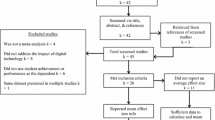Abstract
As today’s preschoolers become the school-age children of tomorrow, early learning educators are faced with a unique and exciting challenge of integrating technology into mathematics instruction. This article examines theory, standards, guidelines, and rationale that supports technology in the preschool environment. Examining practices at 12 diverse preschool sites, four designs emerge as the “typical” models that enable early learners to engage and experience technology within a developmentally appropriate learning environment. The designs outlined are viewed through the lens of preschool mathematics instruction and provide early learning educators as well as parents with models for replication.
Similar content being viewed by others
References
Clements, D. H., & Swaminathan, D. (1995). Technology and school change: New lamps for old?Childhood Education, 71, 275–281.
Goodman, K. (1986).What’s whole in whole language? Portsmouth NH: Heinemann.
Haugland, S. W., & Shade, D. D. (1990).Developmental evaluations of software for young children. Albany NY: Delmar.
Hohmann, C. (1994). Staff development practices for integrating technology in early childhood education programs. In J.L. Wright & D. D. Shade (Eds.),Young children: active learners in a technological age (pp. 104–105). Washington DC: National Association for the Education of Young Children.
Markezich, A. (1997). Learning windows and the child’s brain. [online] available: http://www.susperkids.com/aweb/pages/features/earlyl/earlyl/shtml
Everybody counts: A report to the nation on the future of mathematics education. National Academy Press. (1989). Washington, DC: Author.
National Association for the Education of Young Children (1996).NAEYC position statement: Technology and young children—ages three through eight. [On-line]. Available: http://www.naeyc.org/
Curriculum and evaluation standards for school mathematics. Reston, VA: Author National Council of Teachers of Mathematics, (1989).
Permutter, J. C., Bloom, L., & Burrell, L. (1993). Whole math through investigations.Childhood Education, 70, 20–24.
Turner, J. S. & Helms, D. B. (1991).Lifespan development. Fort Worth, TX: Holt, Rineharr and Winston.
Author information
Authors and Affiliations
Corresponding author
Rights and permissions
About this article
Cite this article
Craig, D.V. Technology, math, and the early learner: Models for learning. Early Childhood Educ J 27, 179–184 (2000). https://doi.org/10.1007/BF02694232
Issue Date:
DOI: https://doi.org/10.1007/BF02694232




